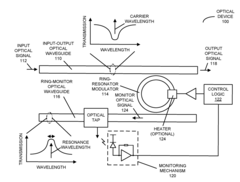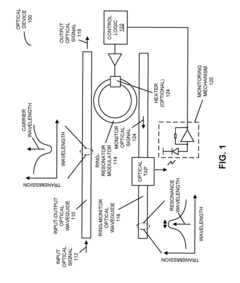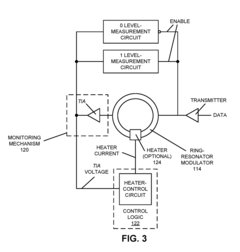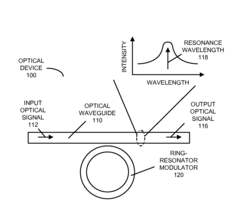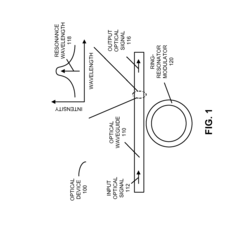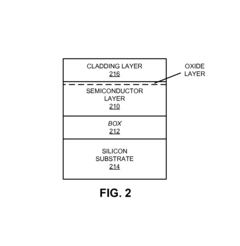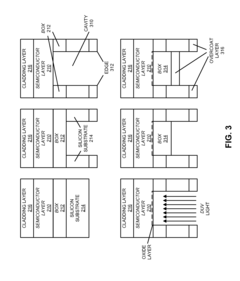The impact of silicon photonics on multimedia delivery systems.
JUL 17, 20259 MIN READ
Generate Your Research Report Instantly with AI Agent
Patsnap Eureka helps you evaluate technical feasibility & market potential.
Silicon Photonics Evolution
Silicon photonics has undergone a remarkable evolution since its inception in the late 1980s. Initially conceived as a means to integrate optical components with electronic circuits, the technology has progressed through several key stages, each marked by significant advancements and breakthroughs.
In the early 1990s, researchers focused on developing basic building blocks such as waveguides, modulators, and detectors on silicon substrates. This period was characterized by proof-of-concept demonstrations and the exploration of fundamental physical properties of silicon as an optical medium.
The turn of the millennium saw a shift towards practical applications, with efforts concentrated on improving device performance and integration density. This era witnessed the development of high-speed modulators, efficient photodetectors, and the first integrated silicon lasers, albeit with limited efficiency.
From 2005 to 2015, silicon photonics entered a phase of rapid commercialization. Major semiconductor companies and startups alike invested heavily in the technology, recognizing its potential to revolutionize data communications. This period saw the emergence of the first commercial transceivers based on silicon photonics, primarily targeting short-reach optical interconnects in data centers.
The most recent phase, from 2015 onwards, has been characterized by the expansion of silicon photonics into new application domains beyond data communications. This includes sensing, LiDAR for autonomous vehicles, and quantum computing. Concurrently, there has been a push towards higher levels of integration, with efforts to combine photonic and electronic components on the same chip.
In the context of multimedia delivery systems, silicon photonics has played an increasingly important role. The technology's ability to handle high bandwidth data transmission has made it particularly relevant for streaming high-definition video and audio content. As multimedia content has grown in size and quality, silicon photonics has evolved to meet the demands for faster, more efficient data transfer.
The evolution of silicon photonics has also been marked by continuous improvements in manufacturing processes. Early devices were fabricated using modified CMOS processes, but as the technology matured, dedicated photonics foundries emerged, offering specialized processes optimized for optical components. This has led to improved yield, reduced costs, and increased scalability, all crucial factors in the widespread adoption of silicon photonics in multimedia delivery infrastructure.
Looking ahead, the evolution of silicon photonics is expected to continue, with a focus on further integration, improved energy efficiency, and expanded functionality. These advancements will likely have profound implications for multimedia delivery systems, enabling even higher bandwidth, lower latency, and more immersive experiences for end-users.
In the early 1990s, researchers focused on developing basic building blocks such as waveguides, modulators, and detectors on silicon substrates. This period was characterized by proof-of-concept demonstrations and the exploration of fundamental physical properties of silicon as an optical medium.
The turn of the millennium saw a shift towards practical applications, with efforts concentrated on improving device performance and integration density. This era witnessed the development of high-speed modulators, efficient photodetectors, and the first integrated silicon lasers, albeit with limited efficiency.
From 2005 to 2015, silicon photonics entered a phase of rapid commercialization. Major semiconductor companies and startups alike invested heavily in the technology, recognizing its potential to revolutionize data communications. This period saw the emergence of the first commercial transceivers based on silicon photonics, primarily targeting short-reach optical interconnects in data centers.
The most recent phase, from 2015 onwards, has been characterized by the expansion of silicon photonics into new application domains beyond data communications. This includes sensing, LiDAR for autonomous vehicles, and quantum computing. Concurrently, there has been a push towards higher levels of integration, with efforts to combine photonic and electronic components on the same chip.
In the context of multimedia delivery systems, silicon photonics has played an increasingly important role. The technology's ability to handle high bandwidth data transmission has made it particularly relevant for streaming high-definition video and audio content. As multimedia content has grown in size and quality, silicon photonics has evolved to meet the demands for faster, more efficient data transfer.
The evolution of silicon photonics has also been marked by continuous improvements in manufacturing processes. Early devices were fabricated using modified CMOS processes, but as the technology matured, dedicated photonics foundries emerged, offering specialized processes optimized for optical components. This has led to improved yield, reduced costs, and increased scalability, all crucial factors in the widespread adoption of silicon photonics in multimedia delivery infrastructure.
Looking ahead, the evolution of silicon photonics is expected to continue, with a focus on further integration, improved energy efficiency, and expanded functionality. These advancements will likely have profound implications for multimedia delivery systems, enabling even higher bandwidth, lower latency, and more immersive experiences for end-users.
Multimedia Delivery Market
The multimedia delivery market has experienced significant growth and transformation in recent years, driven by the increasing demand for high-quality, on-demand content across various platforms. This market encompasses a wide range of services, including video streaming, online gaming, virtual reality experiences, and interactive media applications. The global multimedia delivery market size was valued at $79.5 billion in 2020 and is projected to reach $163.1 billion by 2026, growing at a CAGR of 12.7% during the forecast period.
The rapid expansion of this market can be attributed to several factors. Firstly, the widespread adoption of smartphones and tablets has created a large user base for mobile multimedia consumption. According to recent statistics, there are over 3.8 billion smartphone users worldwide, representing a significant potential audience for multimedia content. Secondly, the increasing availability of high-speed internet connections, including 5G networks, has enabled seamless streaming of high-definition content to multiple devices simultaneously.
Another key driver of the multimedia delivery market is the rise of over-the-top (OTT) platforms and streaming services. Major players like Netflix, Amazon Prime Video, and Disney+ have revolutionized the way content is consumed, leading to a shift away from traditional cable and satellite TV services. The COVID-19 pandemic has further accelerated this trend, with lockdowns and social distancing measures driving increased demand for home entertainment options.
The gaming industry has also played a crucial role in shaping the multimedia delivery market. Cloud gaming services and game streaming platforms have gained traction, allowing users to access high-quality gaming experiences without the need for expensive hardware. This has opened up new opportunities for content delivery and monetization in the gaming sector.
Looking ahead, emerging technologies such as augmented reality (AR) and virtual reality (VR) are expected to create new avenues for multimedia delivery. These immersive technologies require high-bandwidth, low-latency connections to deliver seamless experiences, presenting both challenges and opportunities for the market. The integration of AI and machine learning algorithms in content delivery networks is also expected to optimize streaming quality and personalize user experiences.
As the multimedia delivery market continues to evolve, there is a growing need for more efficient and scalable infrastructure to support the increasing data traffic. This is where silicon photonics technology comes into play, offering the potential to revolutionize the way multimedia content is transmitted and processed. The impact of silicon photonics on multimedia delivery systems is expected to be substantial, addressing key challenges such as bandwidth limitations, power consumption, and latency issues.
The rapid expansion of this market can be attributed to several factors. Firstly, the widespread adoption of smartphones and tablets has created a large user base for mobile multimedia consumption. According to recent statistics, there are over 3.8 billion smartphone users worldwide, representing a significant potential audience for multimedia content. Secondly, the increasing availability of high-speed internet connections, including 5G networks, has enabled seamless streaming of high-definition content to multiple devices simultaneously.
Another key driver of the multimedia delivery market is the rise of over-the-top (OTT) platforms and streaming services. Major players like Netflix, Amazon Prime Video, and Disney+ have revolutionized the way content is consumed, leading to a shift away from traditional cable and satellite TV services. The COVID-19 pandemic has further accelerated this trend, with lockdowns and social distancing measures driving increased demand for home entertainment options.
The gaming industry has also played a crucial role in shaping the multimedia delivery market. Cloud gaming services and game streaming platforms have gained traction, allowing users to access high-quality gaming experiences without the need for expensive hardware. This has opened up new opportunities for content delivery and monetization in the gaming sector.
Looking ahead, emerging technologies such as augmented reality (AR) and virtual reality (VR) are expected to create new avenues for multimedia delivery. These immersive technologies require high-bandwidth, low-latency connections to deliver seamless experiences, presenting both challenges and opportunities for the market. The integration of AI and machine learning algorithms in content delivery networks is also expected to optimize streaming quality and personalize user experiences.
As the multimedia delivery market continues to evolve, there is a growing need for more efficient and scalable infrastructure to support the increasing data traffic. This is where silicon photonics technology comes into play, offering the potential to revolutionize the way multimedia content is transmitted and processed. The impact of silicon photonics on multimedia delivery systems is expected to be substantial, addressing key challenges such as bandwidth limitations, power consumption, and latency issues.
Silicon Photonics Challenges
Silicon photonics faces several significant challenges in its application to multimedia delivery systems. One of the primary obstacles is the integration of photonic components with existing electronic circuits. While silicon photonics offers high-speed data transmission, the interface between optical and electrical signals remains a bottleneck. This integration challenge requires innovative solutions in chip design and manufacturing processes to achieve seamless communication between photonic and electronic elements.
Another critical challenge is the miniaturization of photonic components. As multimedia delivery systems demand more compact and energy-efficient devices, reducing the size of silicon photonic components while maintaining their performance becomes increasingly difficult. This miniaturization effort involves overcoming physical limitations in light manipulation at the nanoscale and developing novel fabrication techniques to produce ultra-small photonic structures.
Thermal management presents a substantial hurdle in silicon photonics for multimedia applications. The heat generated by high-speed data transmission can affect the performance and reliability of photonic devices. Developing effective heat dissipation mechanisms and temperature-stable photonic components is crucial for ensuring consistent performance in multimedia delivery systems.
Cost-effective manufacturing of silicon photonic devices at scale remains a significant challenge. While silicon photonics leverages existing semiconductor fabrication infrastructure, the production of high-quality photonic components with precise optical properties requires specialized processes. Balancing manufacturing costs with performance requirements is essential for widespread adoption in consumer multimedia devices.
The development of efficient light sources integrated into silicon photonic circuits is another ongoing challenge. Silicon's indirect bandgap makes it an inefficient light emitter, necessitating the integration of III-V materials or the exploration of novel light-emitting structures. Creating reliable, high-performance light sources that can be seamlessly integrated with silicon photonics is crucial for comprehensive multimedia delivery solutions.
Lastly, ensuring the long-term reliability and stability of silicon photonic components in multimedia systems poses a significant challenge. These devices must maintain their performance over extended periods and under various environmental conditions. Addressing issues such as material degradation, optical loss, and signal integrity over time is essential for the widespread deployment of silicon photonics in consumer multimedia applications.
Another critical challenge is the miniaturization of photonic components. As multimedia delivery systems demand more compact and energy-efficient devices, reducing the size of silicon photonic components while maintaining their performance becomes increasingly difficult. This miniaturization effort involves overcoming physical limitations in light manipulation at the nanoscale and developing novel fabrication techniques to produce ultra-small photonic structures.
Thermal management presents a substantial hurdle in silicon photonics for multimedia applications. The heat generated by high-speed data transmission can affect the performance and reliability of photonic devices. Developing effective heat dissipation mechanisms and temperature-stable photonic components is crucial for ensuring consistent performance in multimedia delivery systems.
Cost-effective manufacturing of silicon photonic devices at scale remains a significant challenge. While silicon photonics leverages existing semiconductor fabrication infrastructure, the production of high-quality photonic components with precise optical properties requires specialized processes. Balancing manufacturing costs with performance requirements is essential for widespread adoption in consumer multimedia devices.
The development of efficient light sources integrated into silicon photonic circuits is another ongoing challenge. Silicon's indirect bandgap makes it an inefficient light emitter, necessitating the integration of III-V materials or the exploration of novel light-emitting structures. Creating reliable, high-performance light sources that can be seamlessly integrated with silicon photonics is crucial for comprehensive multimedia delivery solutions.
Lastly, ensuring the long-term reliability and stability of silicon photonic components in multimedia systems poses a significant challenge. These devices must maintain their performance over extended periods and under various environmental conditions. Addressing issues such as material degradation, optical loss, and signal integrity over time is essential for the widespread deployment of silicon photonics in consumer multimedia applications.
Current Solutions
01 Integrated photonic devices
Silicon photonics technology enables the integration of various optical components on a single chip. This includes waveguides, modulators, detectors, and other photonic elements, allowing for compact and efficient optical systems. The integration of these components facilitates high-speed data transmission and processing in optical communication networks and computing systems.- Integration of optical and electronic components: Silicon photonics technology enables the integration of optical and electronic components on a single chip. This integration allows for the creation of high-performance, energy-efficient devices that combine the processing power of electronics with the high-speed data transmission capabilities of photonics. The technology utilizes silicon as a substrate material, leveraging existing semiconductor manufacturing processes to produce photonic integrated circuits.
- Optical interconnects and data transmission: Silicon photonics facilitates the development of optical interconnects for high-speed data transmission within and between computer chips. These interconnects use light to transmit data, offering advantages such as higher bandwidth, lower power consumption, and reduced latency compared to traditional electrical interconnects. The technology enables the creation of optical transceivers, modulators, and detectors that can be integrated into silicon-based chips for efficient data communication.
- Waveguide structures and photonic circuits: Silicon photonics employs various waveguide structures to guide and manipulate light on-chip. These structures include strip waveguides, rib waveguides, and photonic crystal waveguides. The technology allows for the design and fabrication of complex photonic circuits that can perform functions such as splitting, combining, filtering, and routing of optical signals. Advanced waveguide designs enable low-loss light propagation and efficient coupling between different components.
- Integration with optical fiber networks: Silicon photonics technology facilitates seamless integration between chip-scale photonic devices and optical fiber networks. This integration enables efficient coupling of light between on-chip waveguides and optical fibers, allowing for high-speed data transmission over long distances. The technology includes the development of specialized coupling structures, such as grating couplers and edge couplers, to minimize losses at the chip-fiber interface.
- Applications in quantum computing and sensing: Silicon photonics is being explored for applications in quantum computing and sensing. The technology enables the creation of integrated photonic circuits that can generate, manipulate, and detect single photons, which are crucial for quantum information processing. Silicon photonics also finds applications in various sensing technologies, including biosensors, chemical sensors, and environmental monitoring devices, leveraging the high sensitivity and compact nature of integrated photonic circuits.
02 Optical interconnects
Silicon photonics is used to develop optical interconnects for high-bandwidth data transmission between chips or within computer systems. These interconnects use light instead of electrical signals, offering advantages in speed, power efficiency, and reduced latency. The technology is particularly beneficial for data centers and high-performance computing applications.Expand Specific Solutions03 Photonic integrated circuits (PICs)
Photonic integrated circuits combine multiple photonic functions on a single chip. These circuits can include lasers, modulators, multiplexers, and detectors, all integrated using silicon photonics technology. PICs enable complex optical processing and are crucial for applications in telecommunications, sensing, and quantum computing.Expand Specific Solutions04 Silicon-based light sources
Developing efficient light sources in silicon is a key challenge in silicon photonics. Research focuses on integrating III-V materials with silicon or engineering silicon to emit light more efficiently. These advancements aim to create on-chip lasers and other light-emitting devices compatible with silicon photonics platforms.Expand Specific Solutions05 Photonic computing and signal processing
Silicon photonics enables the development of optical computing systems and signal processing units. These systems use light for computation and data processing, potentially offering significant improvements in speed and energy efficiency compared to traditional electronic systems. Applications include optical neural networks, optical signal processing, and quantum information processing.Expand Specific Solutions
Key Industry Players
The silicon photonics market for multimedia delivery systems is in a growth phase, with increasing adoption across various industries. The market size is expanding rapidly, driven by the demand for high-speed data transmission and efficient optical interconnects. Technologically, silicon photonics is maturing, with key players like Huawei, TSMC, and IBM making significant advancements. Companies such as GlobalFoundries, Cisco, and Micron are also contributing to the ecosystem, enhancing the technology's applicability in multimedia delivery. Research institutions like MIT and Zhejiang University are pushing the boundaries of silicon photonics, while specialized firms like Advanced Micro Foundry and Lumentum are developing innovative solutions for commercial applications.
Huawei Technologies Co., Ltd.
Technical Solution: Huawei has developed a silicon photonics-based optical interconnect solution for data centers and 5G networks. Their technology integrates laser sources, modulators, and photodetectors on a single chip, enabling high-speed data transmission up to 800 Gbps per wavelength[1]. Huawei's silicon photonics platform supports wavelength division multiplexing (WDM) technology, allowing multiple data streams to be transmitted simultaneously over a single fiber[2]. This approach significantly increases bandwidth capacity and reduces power consumption in multimedia delivery systems. Huawei has also demonstrated the use of their silicon photonics technology in edge computing applications, facilitating low-latency content delivery for augmented and virtual reality experiences[3].
Strengths: High-speed data transmission, increased bandwidth capacity, and reduced power consumption. Weaknesses: Potential challenges in large-scale manufacturing and integration with existing infrastructure.
Cisco Technology, Inc.
Technical Solution: Cisco has developed a silicon photonics platform called Silicon One, which integrates optical and electronic components on a single chip. This technology enables high-bandwidth, low-latency data transmission for multimedia delivery systems. Cisco's silicon photonics solution supports data rates up to 1.6 Tbps per optical engine[4], making it suitable for next-generation data centers and cloud computing infrastructure. The company has also implemented coherent optical technology in their silicon photonics platform, allowing for long-distance transmission of high-quality multimedia content[5]. Cisco's silicon photonics technology incorporates advanced modulation formats and forward error correction techniques to ensure reliable data transmission even in challenging network conditions[6].
Strengths: High-bandwidth capabilities, long-distance transmission, and advanced error correction. Weaknesses: High initial implementation costs and potential compatibility issues with legacy systems.
Core Innovations
In-situ ring-resonator-modulator calibration
PatentActiveUS20180259797A1
Innovation
- An optical device with a ring-resonator modulator having an adjustable resonance wavelength, monitored by a ring-monitor optical waveguide and controlled by a mechanism that adjusts the resonance wavelength based on performance metrics such as average optical power or signal swing, using techniques like thermal tuning or carrier injection to optimize performance.
Single-shot correction of resonant optical components
PatentActiveUS20160238791A1
Innovation
- A photonic chip with a substrate and semiconductor layer, where optical components are trimmed using localized low-temperature oxidation to achieve resonance wavelengths matching target values with high accuracy and stability without thermal or electronic tuning, utilizing deep-ultraviolet radiation and oxygen to modify the effective index of refraction.
Standardization Efforts
Standardization efforts play a crucial role in the widespread adoption and integration of silicon photonics technology in multimedia delivery systems. As the field continues to evolve rapidly, industry stakeholders are collaborating to establish common standards and protocols to ensure interoperability, reliability, and scalability of silicon photonics-based solutions.
Several international organizations are leading the charge in developing standards for silicon photonics. The Institute of Electrical and Electronics Engineers (IEEE) has formed working groups dedicated to creating specifications for optical interconnects and silicon photonics integration. These efforts aim to standardize key aspects such as optical interface definitions, testing methodologies, and performance metrics.
The Optical Internetworking Forum (OIF) is another prominent body actively involved in silicon photonics standardization. Their focus includes defining implementation agreements for high-speed optical interfaces and promoting interoperability between different vendors' products. This work is particularly relevant for multimedia delivery systems, as it ensures seamless integration of silicon photonics components across various network elements.
In parallel, the International Electrotechnical Commission (IEC) is developing standards for silicon photonics packaging and testing. These standards are essential for ensuring consistent quality and performance of silicon photonics devices used in multimedia delivery infrastructure. They cover aspects such as thermal management, reliability testing, and packaging techniques specific to silicon photonics components.
The standardization efforts also extend to the software and control layers of silicon photonics-based systems. Organizations like the Open Networking Foundation (ONF) are working on software-defined networking (SDN) standards that can leverage the capabilities of silicon photonics in multimedia delivery networks. These standards aim to provide a unified framework for managing and optimizing silicon photonics-enabled network resources.
Collaboration between academia and industry is driving many of these standardization initiatives. Research institutions are contributing their expertise in advanced silicon photonics technologies, while industry partners provide insights into practical implementation challenges and market requirements. This synergy is crucial for developing standards that are both technically sound and commercially viable.
As silicon photonics continues to impact multimedia delivery systems, these standardization efforts will play a pivotal role in shaping the technology's future. They will not only facilitate wider adoption but also foster innovation by providing a stable foundation for further development. The resulting standards will enable seamless integration of silicon photonics across various multimedia delivery platforms, ultimately leading to more efficient, high-performance systems capable of meeting the ever-increasing demands of modern multimedia applications.
Several international organizations are leading the charge in developing standards for silicon photonics. The Institute of Electrical and Electronics Engineers (IEEE) has formed working groups dedicated to creating specifications for optical interconnects and silicon photonics integration. These efforts aim to standardize key aspects such as optical interface definitions, testing methodologies, and performance metrics.
The Optical Internetworking Forum (OIF) is another prominent body actively involved in silicon photonics standardization. Their focus includes defining implementation agreements for high-speed optical interfaces and promoting interoperability between different vendors' products. This work is particularly relevant for multimedia delivery systems, as it ensures seamless integration of silicon photonics components across various network elements.
In parallel, the International Electrotechnical Commission (IEC) is developing standards for silicon photonics packaging and testing. These standards are essential for ensuring consistent quality and performance of silicon photonics devices used in multimedia delivery infrastructure. They cover aspects such as thermal management, reliability testing, and packaging techniques specific to silicon photonics components.
The standardization efforts also extend to the software and control layers of silicon photonics-based systems. Organizations like the Open Networking Foundation (ONF) are working on software-defined networking (SDN) standards that can leverage the capabilities of silicon photonics in multimedia delivery networks. These standards aim to provide a unified framework for managing and optimizing silicon photonics-enabled network resources.
Collaboration between academia and industry is driving many of these standardization initiatives. Research institutions are contributing their expertise in advanced silicon photonics technologies, while industry partners provide insights into practical implementation challenges and market requirements. This synergy is crucial for developing standards that are both technically sound and commercially viable.
As silicon photonics continues to impact multimedia delivery systems, these standardization efforts will play a pivotal role in shaping the technology's future. They will not only facilitate wider adoption but also foster innovation by providing a stable foundation for further development. The resulting standards will enable seamless integration of silicon photonics across various multimedia delivery platforms, ultimately leading to more efficient, high-performance systems capable of meeting the ever-increasing demands of modern multimedia applications.
Energy Efficiency Impact
Silicon photonics technology has a significant impact on the energy efficiency of multimedia delivery systems. The integration of optical components on silicon chips enables faster data transmission with lower power consumption compared to traditional electronic systems. This improvement in energy efficiency is particularly crucial for multimedia delivery, which often involves the transfer of large volumes of data.
The use of silicon photonics in data centers, where much of the multimedia content is stored and processed, leads to substantial energy savings. Optical interconnects based on silicon photonics consume less power than their electronic counterparts, especially over longer distances. This reduction in power consumption translates to lower cooling requirements, further enhancing overall energy efficiency.
In network infrastructure, silicon photonics enables the development of more energy-efficient routers and switches. These devices can handle higher data rates while consuming less power, contributing to the overall reduction in energy consumption across the multimedia delivery chain. The ability to transmit data at higher speeds with lower latency also means that content can be delivered more quickly, potentially reducing the total time that network equipment needs to be active.
For end-user devices, such as smartphones and tablets, silicon photonics can lead to improved battery life when accessing multimedia content. By enabling more efficient data transmission and reception, these devices can maintain high-quality multimedia experiences while drawing less power from their batteries. This is particularly important for mobile users who rely on their devices for streaming video, audio, and other multimedia content throughout the day.
In the context of edge computing, which is becoming increasingly important for multimedia delivery, silicon photonics can enhance the energy efficiency of local processing and caching nodes. By reducing the power required for data transmission between edge nodes and central data centers, silicon photonics helps to distribute the energy load more effectively across the network.
The energy efficiency improvements offered by silicon photonics also have broader environmental implications. As multimedia consumption continues to grow globally, the reduced energy footprint of silicon photonics-based systems can help mitigate the environmental impact of this increased data traffic. This aligns with sustainability goals and can contribute to reducing the carbon footprint of the digital entertainment and communication industries.
Looking ahead, ongoing research in silicon photonics aims to further enhance energy efficiency. Developments in areas such as on-chip laser sources, improved modulation techniques, and more efficient photodetectors promise to deliver even greater energy savings in future multimedia delivery systems. These advancements will be crucial in meeting the ever-increasing demand for high-quality multimedia content while maintaining sustainable energy consumption levels.
The use of silicon photonics in data centers, where much of the multimedia content is stored and processed, leads to substantial energy savings. Optical interconnects based on silicon photonics consume less power than their electronic counterparts, especially over longer distances. This reduction in power consumption translates to lower cooling requirements, further enhancing overall energy efficiency.
In network infrastructure, silicon photonics enables the development of more energy-efficient routers and switches. These devices can handle higher data rates while consuming less power, contributing to the overall reduction in energy consumption across the multimedia delivery chain. The ability to transmit data at higher speeds with lower latency also means that content can be delivered more quickly, potentially reducing the total time that network equipment needs to be active.
For end-user devices, such as smartphones and tablets, silicon photonics can lead to improved battery life when accessing multimedia content. By enabling more efficient data transmission and reception, these devices can maintain high-quality multimedia experiences while drawing less power from their batteries. This is particularly important for mobile users who rely on their devices for streaming video, audio, and other multimedia content throughout the day.
In the context of edge computing, which is becoming increasingly important for multimedia delivery, silicon photonics can enhance the energy efficiency of local processing and caching nodes. By reducing the power required for data transmission between edge nodes and central data centers, silicon photonics helps to distribute the energy load more effectively across the network.
The energy efficiency improvements offered by silicon photonics also have broader environmental implications. As multimedia consumption continues to grow globally, the reduced energy footprint of silicon photonics-based systems can help mitigate the environmental impact of this increased data traffic. This aligns with sustainability goals and can contribute to reducing the carbon footprint of the digital entertainment and communication industries.
Looking ahead, ongoing research in silicon photonics aims to further enhance energy efficiency. Developments in areas such as on-chip laser sources, improved modulation techniques, and more efficient photodetectors promise to deliver even greater energy savings in future multimedia delivery systems. These advancements will be crucial in meeting the ever-increasing demand for high-quality multimedia content while maintaining sustainable energy consumption levels.
Unlock deeper insights with Patsnap Eureka Quick Research — get a full tech report to explore trends and direct your research. Try now!
Generate Your Research Report Instantly with AI Agent
Supercharge your innovation with Patsnap Eureka AI Agent Platform!
